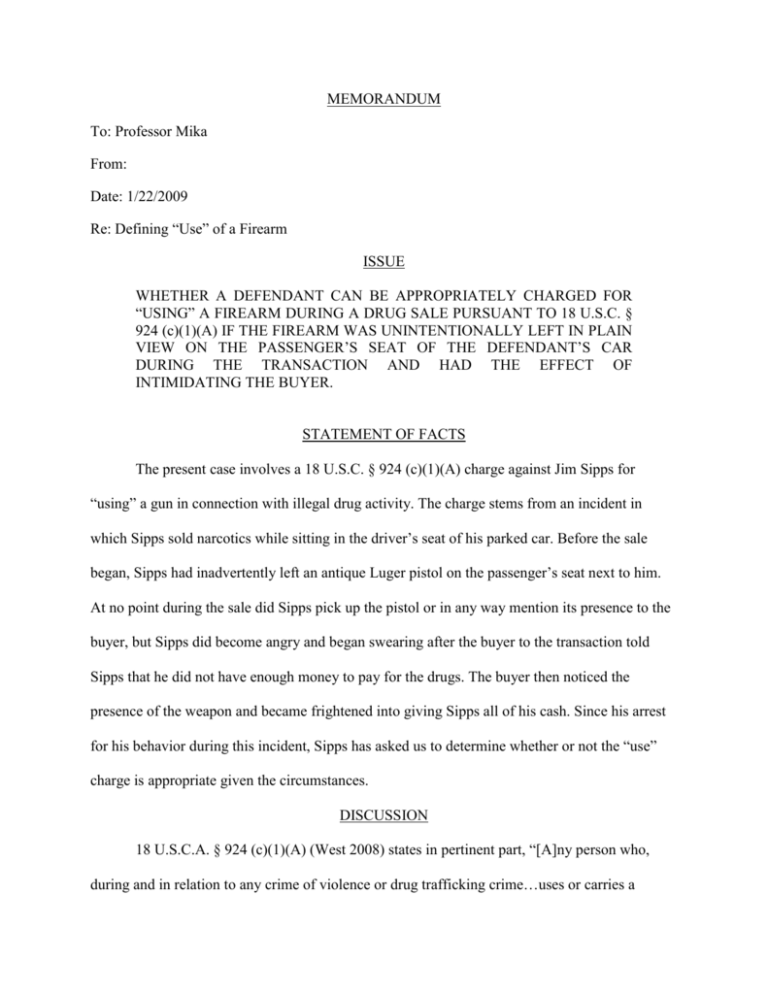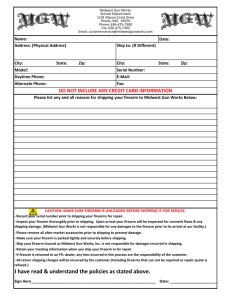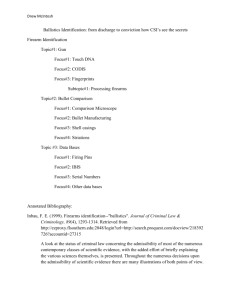sippssample
advertisement

MEMORANDUM To: Professor Mika From: Date: 1/22/2009 Re: Defining “Use” of a Firearm ISSUE WHETHER A DEFENDANT CAN BE APPROPRIATELY CHARGED FOR “USING” A FIREARM DURING A DRUG SALE PURSUANT TO 18 U.S.C. § 924 (c)(1)(A) IF THE FIREARM WAS UNINTENTIONALLY LEFT IN PLAIN VIEW ON THE PASSENGER’S SEAT OF THE DEFENDANT’S CAR DURING THE TRANSACTION AND HAD THE EFFECT OF INTIMIDATING THE BUYER. STATEMENT OF FACTS The present case involves a 18 U.S.C. § 924 (c)(1)(A) charge against Jim Sipps for “using” a gun in connection with illegal drug activity. The charge stems from an incident in which Sipps sold narcotics while sitting in the driver’s seat of his parked car. Before the sale began, Sipps had inadvertently left an antique Luger pistol on the passenger’s seat next to him. At no point during the sale did Sipps pick up the pistol or in any way mention its presence to the buyer, but Sipps did become angry and began swearing after the buyer to the transaction told Sipps that he did not have enough money to pay for the drugs. The buyer then noticed the presence of the weapon and became frightened into giving Sipps all of his cash. Since his arrest for his behavior during this incident, Sipps has asked us to determine whether or not the “use” charge is appropriate given the circumstances. DISCUSSION 18 U.S.C.A. § 924 (c)(1)(A) (West 2008) states in pertinent part, “[A]ny person who, during and in relation to any crime of violence or drug trafficking crime…uses or carries a firearm…shall, in addition to the punishment provided for such crime of violence or drug trafficking crime-- be sentenced to a term of imprisonment of not less than 5 years.” The “use” in question must have a “purpose or effect with respect to the drug transaction.” Smith v. United States, 508 U.S. 223, 238 (1993). A “use” is not limited to a firing or discharging of the weapon. Id. at 236. However, a firearm must be "actively employed” in the course of drug trafficking to qualify as a “use.” Bailey v. United States, 516 U.S. 137, 145 (1995). The “silent but obvious and forceful presence” of a weapon on display during a drug transaction qualifies as such an “active employment.” Id. at 148. Based on relevant case law, Sipps’ behavior in relation to the firearm during the drug transaction would likely qualify as a “use” under 18 U.S.C.A. § 924 (c)(1)(A). Though Sipps never handled the gun and made no other references to it, a jury may properly find that the weapon, in the plain view of the buyer during the course of the drug transaction, was being “actively employed.” Furthermore, the fact that the other party to the transaction was intimidated by the firearm combined with Sipps’ aggressive behavior is concrete evidence that the existence of the firearm became an active element in facilitating the drug deal. Thus any argument that the weapon’s effect on the transaction was immaterial is likely to fail. An example of a similar case in which a “use” charge was upheld against a defendant is United States v. Hathaway, No. 90-509, 1996 U.S. Dist. LEXIS 2872. In that case, a defendant opened a locked safe that contained both guns and drugs in order to measure out and sell some of the drugs to another party, yet made no overt references to the weapons. Id. at *3. The weapons were in plain view of an undercover DEA agent, who was attempting to execute the purchase of narcotics. Id. The court found that the presence of the guns during the transaction constituted a “use” because the weapons were displayed by the defendant and available within his reach, and thus “actively employed” for the purpose of breaching the statute. Id. at *5.; see also United States v. Ramos, 147 F.3d 281 (3rd Cir. 1998) (holding that guns lying on a table next to drugs constituted a “use”); United States v. Horvath, 94-CR-388, 1996 U.S. Dist. LEXIS 2388 (holding that a shotgun merely present in a garage near a meth-lab qualified as a “use”). The present case is similar to the facts of Hathaway in several respects. Both Sipps and the defendant in Hathaway engaged in the illegal sale of drugs while in close proximity to clearly visible firearms in their constructive possession. No. 90-509 at *3. In both instances neither defendant made any verbal or otherwise suggestive references to the presence of the firearms. Id. Despite the fact that Sipps may have not consciously intended to have the firearm nearby as a tool for intimidating the other party, applying the interpretation of the statute used in Hathaway this is irrelevant. Id. at *4. Sipps still “used” the firearm because the weapon was “actively employed” through its “silent but forceful presence” and potential to affect other parties to the transaction. Id.; accord Bailey, 516 U.S. at 148. A counter-interpretation maintained by some courts is that if the gun is inadvertently present at the scene of the crime, this does not necessarily qualify as an “active employment.” For example, in United States v. French, No. 95-30386, 1996 U.S. App. LEXIS 20292, the United States Court of Appeals for the Ninth Circuit held that a firearm which happened to be clearly visible near the feet of a defendant and in close proximity to his illegal drug operations at the time of his arrest did not count as a “use” under 18 U.S.C. § 924 (c)(1)(A). The court overturned the defendant’s “use” conviction because the weapon in question was inadvertently near the scene of the crime, not employed to protect a drug enterprise, and because the defendant peacefully submitted to the authorities. Id. at *5. The court reasoned that such a weapon’s presence must be actively disclosed by the defendant in order to be “used.” Id.; see also United States v. Hall, 110 F.3d 1155 (5th Cir. 1997) (holding that a defendant cannot be said to have “used” firearms that simply happened to be strewn about a drug-dealer’s trailer); Crowder v. United States, 920 F. Supp. 675 (W.D.N.C. 1996) (holding that a drug-dealing defendant who happened to have a firearm in his car near a pile of drugs had not “used” the weapon before he was arrested). An argument could be made that like the defendant in French, Sipps did not intend to have the Luger nearby during the transaction and therefore cannot be found guilty of having “used” the firearm. French, No. 95-30386 at *5. In supporting such an argument, Sipps could point to the fact that at no point did he make any sort of reference to the weapon in order to gain an advantage during the course of the transaction. Id. However, in the present case the buyer was intimidated by Sipps’ abusive behavior coupled with the presence of the firearm. This additional fact separates the present situation from a case like French, and will likely support the conclusion that Sipps did “actively employ” the weapon during the course of the transaction. An example highlighting this separation can be found in Polcano v. United States, 935 F. Supp. 372, 375 (S.D.N.Y. 1996), where the U.S. District Court for Southern New York found that a situation in which the visibility of a firearm was coupled with the subsequent erratic behavior of a defendant would constitute a “use” if the visibility and erratic behavior combined to intimidate another party to a drug transaction. In that case, one of two drug dealers had a gun on his waist during a drug transaction. Id. at 374. When he began to “jump around”, the buyer became intimidated into submitting to their price demands. Id. The court ruled that the defendant’s behavior as well as the presence of the gun had brought about a change in the course of the transaction, and thus he had “actively employed” the firearm. Id. at 375. The court also stated that the situation presented an even more threatening scenario than the “silent but obvious” presence of a gun, because the firearm encroached on the freedom of the buying party. Id. The Polcano example likely distinguishes the Sipps situation from a case like French, because the defendant in French did not show any behavior in the presence of the weapon which might have elicited a response from another party; he simply submitted to the authorities. French, No. 95-30386 at *5.The verbal abuse directed at the buyer in the present case takes the mere visibility of the weapon out of the potential category of being unconnected to the crime and into the category of active display in furtherance of a crime, because it allowed Sipps to impress his will upon the transaction. Polcano, 935 F. Supp. at 375. His acquisition of the demanded money was a direct result of the buyer’s fear that resulted from both the demeanor of Sipps and the presence of the Luger. Id. CONCLUSION Anyone who uses a firearm while engaged in illegal drug activity may be sentenced to a five year prison term in addition to any penalty for drug activity. 18 U.S.C.A § 924 (c)(1)(A) (West 2008) The “silent but obvious” presence of a weapon lying in close proximity to any such activity constitutes a “use” for the purpose of breaching the statute. Bailey, 516 U.S. at 148. Moreover, the presence of a firearm during a drug transaction in which another party becomes intimidated as a result of both the weapon’s presence and the party’s interpretation of the defendant’s behavior is such a “use.” Polcano, 935 F. Supp. at 375. The present situation likely qualifies as a “use” because the presence of the weapon during the drug exchange coupled with the aggressive behavior of Sipps had the effect of frightening the buyer. Under these circumstances, the presence of the weapon actively gave Sipps the ability to change the course of the illegal drug activity.








